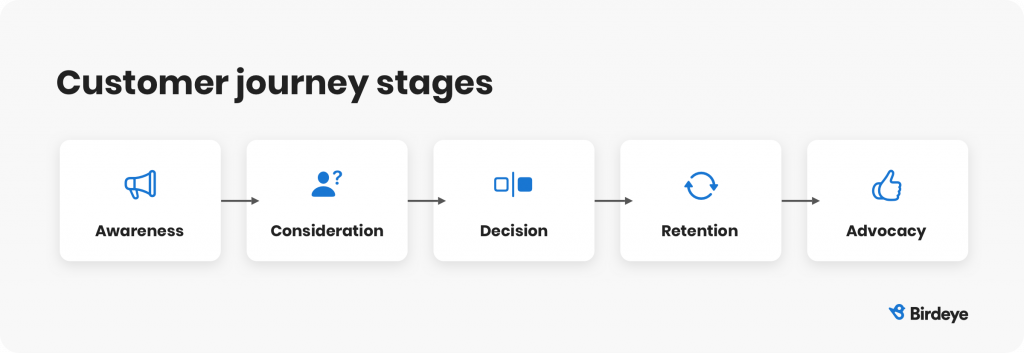A single bad experience can turn a loyal customer away from your business forever. It sounds harsh, but it’s an unfortunate reality. The first step towards providing a consistent service is understanding how and when your customers interact with your business. Customer journey mapping forms the foundation for a solid long-term customer relationship.
- Customer journey stages
- Who should be involved in building a customer journey map?
- Map the customer journey remotely
- Customer journey mapping template
- How to use the customer journey map effectively
- Use an experience marketing platform
Frequently asked questions about customer journey mapping
The customer journey is all the ways that customers get a chance to interact with your business, from discovery to purchase. Understanding what draws customers to your business and what steps they take before purchasing will help you better understand your customer journey.
It is difficult to grow your business if you don’t understand your customers. Outlining the customer journey helps you set up CX measurement metrics in place at each step of the journey to identify how well you are serving your customers, and where you might be losing prospects.
No, these are two different concepts. Think about it this way. The customer journey is what the customer does at each interaction with your business. Customer experience is how your customer feels about their interactions with your business.
“Touchpoints” are points of contact between a business and its customer. Common touchpoint examples include advertisements, the business’s website, emails, newsletters, phone calls, text messages, and any communications between the business and its customer.
A customer journey map is a visual representation of how customers are interacting with your business through various different touchpoints.
A successful customer journey is meant to help your business understand how you can more effectively deliver value across each touchpoint. Ideally, you will get more insight into the needs of your customers and understand how you can deliver more value across the board.
Customer journey stages
Typically, the customer journey is broken down into the following 5 stages.

In order to effectively move your customers through this journey, it’s important to deliver content that makes sense at their current stage. For example, a prospect in the “consideration” phase might want to better understand the competitive advantage that you have over other offerings. In this case, you might want to provide a landing page that shows some of your business’s key differentiators over the competition.
Who should be involved in building a customer journey map?
Building a customer journey map is a cross-functional exercise. It should involve not just marketing and sales, but engineering, finance, and every other part of your company that’s involved with the customer journey.
C-suite executives need to be involved as well. Without the support of the top levels of the organization, building a customer journey map often turns into a fruitless exercise. It’s important to make the insights you get from this exercise turn into action.
Map the customer journey remotely
With the onset of the COVID-19 pandemic, more and more businesses are wondering how they can kick start the process of mapping a customer journey while everyone is working remotely. While it might lack the electricity of an in-person session, it’s still possible to build a great customer journey on a platform like Zoom or Google Hangouts.
We do recommend that you use a whiteboard tool. That way, it’s easy for your team to illustrate different parts of the customer journey visually.
Customer journey mapping template
Here is a template that you can use to get started mapping your customer journey. While you look through it, keep in mind that this just meant to help you think in the right direction. There is no right way to draw up a customer journey map and you might want to do things differently based on your business’s unique situation.
Step 1: Build customer personas
The better you understand your customers, the more you will be able to provide them with experiences that align with and even exceed their expectations. In turn, that drives more customer loyalty and over time, more revenue.
Consider these questions when building your customer personas:
- What is the age and demographic group of your customers?
- What problem is the customer looking to solve?
- What goals are our customers looking to achieve?
To get the answers to these questions, consider scheduling some time to talk to some of your customers. Make it clear that this is not a sales call and you’re only seeking more information to improve your business operations.
Next, conduct some customer surveys. This can be a great way to get a high volume of feedback from potential customers. While the feedback might not be as in-depth as the feedback you can get in a phone conversation, you can survey a much broader audience and eliminate the possibility of being led astray by potentially anecdotal information.
Finally, look through your customer database and see if there are some common traits that you can identify with your most loyal customers. See if there is a demographic or an age group that typically spends more money at your business and ask yourself whether these customers have any common characteristic that you can put into your personas
Step 2: Determine the stages of your customer journey
Once you’ve built customer personas, it’s time to identify the journey that your prospects take in order to become customers. It’s important that you are able to clearly label when a prospect goes from one phase to the next, such as going from the “awareness” phase to the “consideration” phase. Identify content that you can use to make this journey more smooth.
List out all of the touchpoints that your customers are currently using, as well as the ideal journey that you would want them to take to move through these different phases. It might be helpful to experience the customer journey yourself to get a better understanding of how it works.
Step 3: Understand customer motivations
In order to make sure that your customers are going through the entire customer journey, it’s important that you understand their motivations for either dropping off or moving on to the next part of the journey.
When you get a good understanding of your customer motivations, you’ll be able to create content that truly speaks to their desires. Perhaps some of your customers who’ve reached the “consideration” phase want to see case studies and testimonials from some of your past customers. That means it might be good to start putting more quotes like these on relevant areas on your website.
In order to uncover obstructions, it’s important to take customer surveys at every touchpoint. Once you parse through customer feedback, you’ll be able to create a plan of action for dealing with these obstructions.
Step 4: Find the tools that you’ll need
When you make your customer experience map, you might find a few weaknesses. These might be different for every business. While some businesses don’t have the tools to connect with customers in their preferred mediums, other businesses may not have the feedback they need to get visibility into customer motivations.
Consider investing in tools that can help you improve your current weak points. While it may sometimes be difficult to convince management to make these investments, remember that customer experience is an investment that pays off.
How to use a customer journey map effectively
The work isn’t finished when you’ve completed your customer journey map. Now, your team needs to put in the work to make sure that the insights that you’ve gained from the exercise can be implemented. To ensure that this happens, make sure that executive members included in your customer journey mapping session are pushing for the change that needs to happen.
Once you’ve started to make changes in your operations, you’re not finished. Customer journey mapping is a constant work in progress. Take some time with your team to regularly review the map that you’ve made. See whether you’ve made progress in removing obstacles and making the process easier for potential customers to navigate.
Use an Experience Marketing platform
The process of building a customer journey map is significantly easier with an Experience Marketing platform. Birdeye can help.
Birdeye gives multi-location businesses the tools they need to manage customer experience from start to finish. The platform helps businesses get discovered in search results, interact with customers via website chat and text messaging, and collect quality feedback through customer surveys.

Originally published









